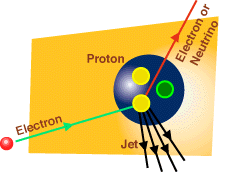
 measure
the structure of the proton
measure
the structure of the proton
 study
fundamental interactions between particles
study
fundamental interactions between particles
 search
for physics beyond the Standard Model of the elementary particles.
search
for physics beyond the Standard Model of the elementary particles.

 |
|
|
|
|
|
|
|
||
Areas of Research
The characteristics of the particles detected after such a collision provides access to the following areas of current research:
|
| last updated by H1 webmaster on 27/02/03 |